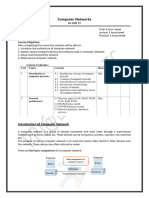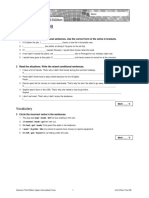Computer
Networks
.
What is a computer network
A computer network is a system in which multiple computers are
connected to each other to share information and resources.
• A network can be defined as two
or more computers connected
together in such a way that they
can share resources.
A collection of computing devices
that are connected in various way
in order to communicate and share
resources.
Usually, the connections between
computers in a network are made
using physical wires or cables.
Example
• Do you prefer these?
A resource may be: • Or this?
A file
A folder
A printer
A disk drive
Or just about
3 anything else that exists on a computer.
What is Networking
Networking is a practice of linking of two or
more computing devices such as PCs printers
etc.
with each other connections between two
devices is through physical media to share the
information, data and resources.
Network are made with hardware and software.
Need For Networking
RESOURCE SHARING
Makes all programs, data and peripherals available to anyone
on the network irrespective of the physical location of
resources and the user.
RELIABILITY
A file can have copies on two or three machines so if one of
them is unavailable due to any reason, the other copy could
be used.
COST FACTOR
Results in less cost consumption because of sharing of
resources.
COMMUNICATION MEDIA
It helps in communication between different people located at
different places.
Components of Networks
Workstation/Nodes/ Client
• Refers to a computer that are attached to a network.
These type of computers normally request
and receive information over the Server
network.
Such type of computers also depends
primarily on the central server
for processing activities .
Server
• The master computer is called server.
• It facilitates the sharing of
data, s/w and h/w concepts.
• It also control mechanism
for workstations.
Fundamental Network Classifications
Local Area Networks (LANs):
A Local Area Network (LAN) is a network that is confined to a
relatively small area.
It is generally limited to a geographic area such as a computer lab,
school, or building.
In a typical LAN configuration, one computer is designated as a
server. It stores all of the software that controls the network, as well
as the software that can be shared by the computers attached to the
network.
Computers connected to the file server are called workstations.
On most LANs, cables are used to connect the network interface cards
in each computer.
LAN examples
Metropolitan Area Network (MAN):
o A metropolitan area network (MAN) is a network
that interconnects users with computer resources
in a geographic area .
o or region larger than that covered by even a large
local area network (LAN) but smaller than the area
covered by a wide area network (WAN).
o It is also sometimes referred to as a campus
network.
MAN Example………
Wide Area Networks (WANs):
The largest network of all network types.
WAN generally covers large distances such as states, countries or
continents.
WAN is a group of MANs or LANs or the mixture of both networks.
Wide Area Network (WAN) is a computer network that covers a broad area
(i.e., any network whose communications links cross metropolitan, regional,
or national boundaries).
WANs are used to connect LANs and other types of networks together, so
that users and computers in one location can communicate with users and
computers in other locations
Or, less formally, a network that uses routers and public communications
links
The largest and most well-known example of a WAN is the Internet.
WAN Example………
Comparison of LAN, MAN, WAN
Evolution of Network
In 1969 , US deptt of Defence started ARPANET
( Advance Research Projects Agency NETwork).
Goal was to connect different universities and US
defence department.
It Expanded rapidly
Network architecture
Client/Server Network:
A client/server network is a
network in which the shared
files and applications are
stored in the server but
network users (clients) can
still store files on their
individual PCs.
A server is a computer
that shares information
and resources with other
computers on a network.
A client is a computer
which requests services
or files from a server
computer.
Peer-to peer network:
A peer-to-peer network is a network
where the computers act as both
workstations and servers.
Good for small, simple, and
inexpensive networks.
In a peer-to-peer
networking setup, every computer
is an equal.
Each machine can have resources
that are shared with any other
machine.
There is no assigned role for any
particular device, and each of the
devices usually runs similar software.
Differences
APPLICATIONS OF COMPUTER
NETWORK
File sharing.
Printer sharing.
Communication and collaboration.
Remote access.
Data protection.
Centralized Support and Administration.
Network Devices
RJ-45 CONNECTOR
• The Registered Jack-45 connector is commonly used for
network cabling and for telephony applications.
• It is an eight wire connector which
is commonly used to connect computers
on the local area networks,
especially Ethernets.
• It is similar to telephone
connector RJ-11 except that it has
eight wires as compared to 4 in RJ-11.
Switch
A switch is a network device which filters and forwards data packets across
a network.
A network switch is a computer networking device that connects network
segments.
Network switches are capable of
inspecting data packets as they
are received, determining the
source and destination device
of that packet and forwarding
it appropriately.
Switches differ from hubs in that
they can have ports of different
speed.
Repeater
• It is a device that amplifies and restores a signal being
transmitted on the network.
• A repeater is an electronic device that receives a weak or
low-level signal and retransmits it at a higher level or higher
power, so that the signal can cover longer distances without
degradation.
• It is used in long network lines.
Bridge
It is network device which connects two or more
local area networks (LANs) together.
In computer networks, a bridge is a device that
connects a local area network (LAN) to another
local area network that uses the same Hardware
and software.
Router
Router is a specialized network device used to interconnect
different types of computer network that uses different
Hardware and software format.
A router can be used to connect
a Local Area Network (LAN) to another LAN,
a Wide Area Network (WAN) to another WAN,
Routers transmit data packets through these networks.
Gateway
A gateway is a network point that acts as an
entrance to another network.
OR
A node on a network that serves as an entrance
to another network.
A gateway can be Hardware software or both.
A router ,firewall and server can be work as
gateway in computer network.
TRANSMISSION MEDIA
•Transmission media enable computers to send and
receive messages.
•Computers can communicate through cables, light,
and radio waves.
•Let us learn about three basic types of cables
used:
• Twisted pair Cable
• Coaxial Cable
• Optical Fiber
TWISTED PAIR CABLE
•It consists of two identical wires wrapped together.
•Simplicity and ease of installation.
•Low cost
The 8 pin modular jacks at both
ends of an Ethernet cable, clearly
showing the wire pairs inside.
COAXIAL CABLE
The structure of coaxial cable consists
of four main components as shown in
the picture below.
Another ex: Cable coaxial RG-59.
A: Plastic Jacket
B: Metallic Core
C: Dialetric Insulator
D: Center Core
Data transmission characteristics are much better than twisted pair
cable.
cost is more than Twisted pair cable.
OPTICAL FIBRE
It consists of thin fiber of glass or glass like material to transmit
data modulated onto light waves.
They carry light from a source at one end of the fiber
to a detector at the other end.
Advantage
Capable of carrying more data.
•Less in interference from outside world.
•Much thinner.
•Data can be transmitted digitally rather than analogically.
Disadvantage
•Expensive to install.
MICROWAVE LINK
•For long distance communication, microwave radio transmission
is widely used.
Microwave is a direct line-of-sight transmission.
The Microwave communication consists of a transmitter,
receiver and the atmosphere.
In microwave communication, parabolic antennas are mounted
on towers to send a beam to other antennas .
•Microwave link use repeaters at intervals of about 25 to 30 km in
between the transmitting and receiving stations.
THANK YOU


































































































